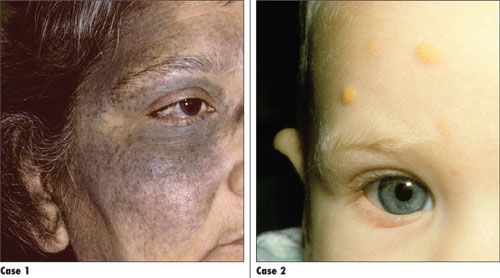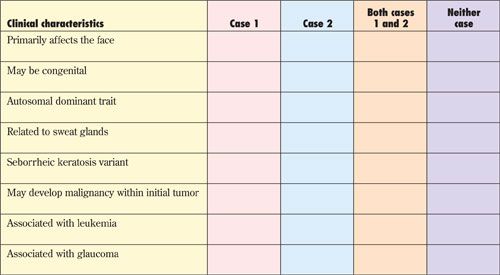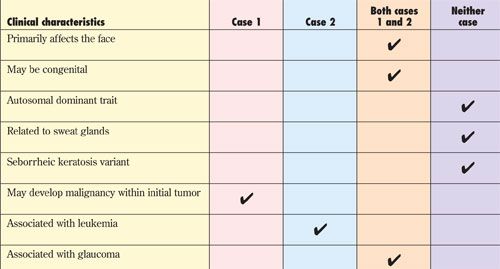Can You Identify These Congenital Lesions?
Both of the disorders presented in Cases 1 and 2 typically have the face as the primary site of involvement, and both are benign processes

Match the following characteristics with the clinical disorders pictured in the photographs of Cases 1 and 2. Then read the brief descriptions that follow on the next page to see how well you did.

Answer on next page
The Correct Answers

DISCUSSION
Both of the disorders presented in Cases 1 and 2 typically have the face as the primary site of involvement, and both are benign processes, at least at the outset. Case 1 depicts a nevus of Ota, while Case 2 demonstrates a classic example of juvenile xanthogranuloma.
Case 1 is a 42-year-old woman whose skin lesion was first noted at birth; the affected area and depth of pigmentation have been increasing since infancy. This is an excellent example of nevus of Ota, which most frequently presents as blue-to-gray, speckled and coalescing macules or patches that involve periorbital skin (including the forehead, temple, and malar areas). The sclera and, rarely, the underlying oral mucosa may also be affected by this nonfamilial dermal melanocytosis.
Persons who have “skin of color,” particularly those of Asian ethnicity, are at highest risk, and women are affected about 5 times more frequently than men. The prevalence of nevus of Ota among ethnic Japanese is about 0.5%.1 Some 90% of cases are unilateral; the remaining cases are bilateral in distribution. Most lesions are present at or near birth, although delayed onset until adolescence also has been observed.
Potential complications of this otherwise benign disorder include elevated intraocular pressure and/or overt glaucoma (about 10% of affected persons) and development of cutaneous, intracranial (meningeal), or ocular malignant melanoma within the primary lesion (uncommon).2-4 Patients often desire removal of the lesions for cosmetic reasons. The appearance of nevus of Ota can be almost always strikingly improved, if not totally eliminated, by laser ablation. High success rates and minimal adverse effects have been reported with the Q-switched ruby, Q-switched alexandrite, and Q-switched Nd:YAG lasers.5,6 Other modalities previously employed, such as dermabrasion and cryosurgery, have largely been abandoned because of a much higher risk of scarring and a much lower rate of success.
Case 2 is a 1-year-old girl whose skin lesions were also noted at birth. The lesions have grown slightly and become more yellow since birth. Biopsy disclosed the typical appearance of juvenile xanthogranuloma (also called nevoxanthoendothelioma), which represents a benign proliferation of non-Langerhans cell histiocytes, possibly of plasmacytoid monocytic origin.7 The prototypical brown to yellow color results from the accumulation of foamy, lipid-laden histiocytes. This benign tumor occurs primarily in whites (10:1 ratio compared with African Americans). Juvenile xanthogranuloma is slightly more common in males than in females. It is present at birth in about 35% of affected persons; nearly 75% of such lesions develop within the first year of life.8 Solitary cutaneous lesions are found in more than 80% of cases and are typically nodular; when multiple lesions are present, they are usually smaller and papular. About 4% of affected patients may have extracutaneous lesions, most commonly affecting the iris of the eye, but also potentially involving the lung, bone marrow, and liver.9 Glaucoma may accompany intraocular juvenile xanthogranuloma.10 Juvenile myelomonocytic leukemia has been observed in association with multiple juvenile xanthogranulomas.
Neither a specific inheritance pattern nor a specific genetic defect has been identified. However, juvenile xanthogranuloma has been associated with a variety of hereditary syndromes, including neurofibromatosis (NF-1), urticaria pigmentosa, and Niemann-Pick disease.
Because the vast majority of juvenile xanthogranulomas resolve spontaneously, watchful waiting is the best approach. Among childhood cases, resolution usually occurs by 5 years of age. For nonhealing lesions, surgical excision is the most efficient and safest treatment. For widespread or symptomatic systemic lesions, a course of oral corticosteroids may be employed, with or without adjunctive chemotherapy.11,12